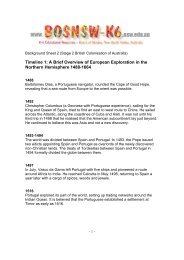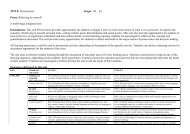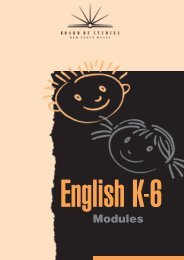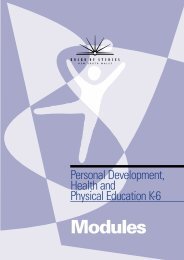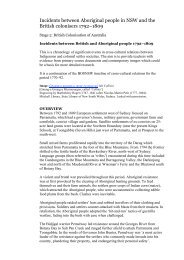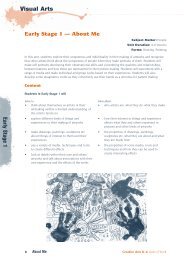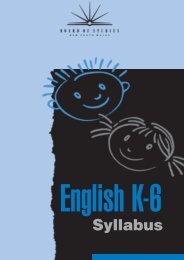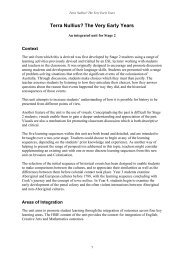Math K-6 WS - K-6 Educational Resources
Math K-6 WS - K-6 Educational Resources
Math K-6 WS - K-6 Educational Resources
Create successful ePaper yourself
Turn your PDF publications into a flip-book with our unique Google optimized e-Paper software.
<strong>Math</strong>ematicsK-6 Early Stage1<br />
WM<br />
Domino Count<br />
Students are given a set of dominoes and are asked to count<br />
how many dots are on each side of a domino and then how<br />
many dots there are altogether. Students are encouraged to:<br />
❚ work out how many dots there are on each side without<br />
counting one at a time<br />
❚ discuss different strategies they could use to work out<br />
how many there are altogether.<br />
The teacher could ask the students to imagine a domino with<br />
four dots on one side and one dot on the other. They then<br />
discuss with students how many dots there are and strategies<br />
that can be used to find out.<br />
The teacher could also pose the problem:<br />
‘There are six dots altogether on my domino. How many dots<br />
could there be on each side?’<br />
Students record and discuss the possible answers. Some<br />
students may require materials such as counters to assist them<br />
in solving the problem.<br />
Possible questions include:<br />
❚ is there a quicker way to find the answer than counting<br />
by ones from one?<br />
❚ is there a quicker or easier way to add?<br />
❚ is that the only possible answer?<br />
Combinations to Ten<br />
Students are given a container of 10 counters that are all one<br />
colour on one side and a different colour on the reverse.<br />
In pairs, students shake the container and roll the counters<br />
onto the floor. Students sort the counters into colour groups,<br />
depending on which side the counters land. Students should<br />
be encouraged to organise the groups so they can see ‘how<br />
many’ at a quick glance<br />
eg<br />
●● ●●●●<br />
● ● ● ● ●●<br />
Sample Units of Work<br />
Students determine how many counters are, for example, red<br />
and how many are yellow.<br />
Students use drawings and numerals to record their results.<br />
18<br />
●●●●● ●<br />
●●●●● ●<br />
Teen Numbers Plus<br />
The teacher prepares a set of dot cards for the numbers 1 to<br />
10 and a set of number cards from 11 to 19, as shown.<br />
● ●● ●● ●● ●●<br />
● ●● ●●●<br />
All dot cards are turned face down, but kept in sequence.<br />
In small groups, a student turns over two of the dot cards and<br />
states how many dots there are altogether. If the answer is one<br />
of the teen number cards, the student removes the number<br />
card and the dot cards are turned face down again.<br />
Play continues in turn until all of the teen number cards have<br />
been collected.<br />
WM<br />
Hidden Counters<br />
Students are given a small number of counters to count.<br />
The teacher picks up the counters with one hand, puts both<br />
hands behind their back, distributes the counters between<br />
their two hands and closes their fists.<br />
Students are then shown the two closed fists. One hand is<br />
opened and the students see the number of counters in that<br />
hand. Students determine how many counters the teacher has<br />
in the other hand and explain how they worked it out.<br />
The activity is repeated many times and the number of<br />
counters is varied.<br />
Variation: Students play this as a game with a partner.<br />
(Adapted from CMIT)<br />
Comparing Towers<br />
●●<br />
●●<br />
●●<br />
11 12 13 14 15<br />
16 17 18 19<br />
●●<br />
●●<br />
●● ●<br />
In pairs, Student A rolls a die, collects the corresponding number<br />
of interlocking cubes and makes a tower. Student B then rolls the<br />
die, collects the corresponding number of interlocking cubes and<br />
makes a tower. The two students compare their towers and are<br />
asked to determine whose tower is taller.<br />
Possible questions include:<br />
❚ how do you know which tower is taller?<br />
❚ how many cubes are in each tower?<br />
●●<br />
●●<br />
●●<br />
●●<br />
●●<br />
●●<br />
●●<br />
●● ●<br />
●●<br />
●●<br />
●●<br />
●●<br />
●●<br />
❚ how many more cubes are in the taller tower?<br />
The student with the taller tower removes the ‘difference’ and<br />
keeps it. The game continues until students have collected up<br />
to 30 cubes.<br />
Students may also use two or three dice, or dice with numbers<br />
larger than 6. (Adapted from CMIT)



